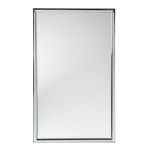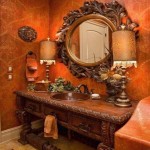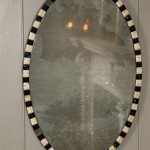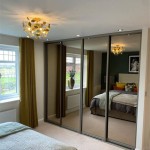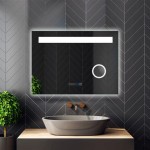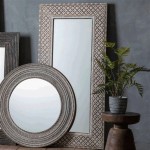Do I Need a Stud to Hang a Mirror?
Hanging a mirror can transform a room, adding light, depth, and style. However, ensuring it's securely mounted is crucial for safety and prevents damage. One common question homeowners face is whether a wall stud is always necessary for hanging a mirror.
The answer isn't always straightforward. Several factors influence the decision, including the mirror's weight, size, wall construction, and the type of mounting hardware used. This article explores these considerations to help determine the best approach for hanging a mirror securely.
Factors Influencing Stud Mounting Necessity
Understanding the interplay of these factors is key to making an informed decision:
*Mirror Weight:
Heavier mirrors exert more force on the wall, making stud mounting essential for adequate support. Lightweight mirrors may offer more flexibility in mounting options. *Mirror Size:
Larger mirrors, even if relatively lightweight, distribute weight over a wider area. This increased surface area can put more strain on the wall, often necessitating stud mounting for stability. *Wall Construction:
Different wall types offer varying levels of support. Drywall, a common material, provides less support than plaster or masonry walls. Stud mounting is generally recommended for drywall installations, especially with heavier or larger mirrors. *Mounting Hardware:
The chosen hardware plays a significant role in determining the need for stud mounting. Heavy-duty anchors can sometimes provide sufficient support in drywall without directly hitting a stud, especially for lighter mirrors.Exploring Wall Anchors as Alternatives
Wall anchors provide an alternative to stud mounting, particularly for lighter mirrors or when studs aren't conveniently located. Various types of wall anchors offer different levels of support:
*Toggle Bolts:
These anchors are suitable for heavier items in hollow walls. They use a spring-loaded toggle that expands behind the wall, providing a secure grip. *Molly Bolts:
Another option for hollow walls, molly bolts use a sleeve that expands when the bolt is tightened, creating a firm anchor point. *Plastic Expansion Anchors:
These anchors are suitable for lighter items and are relatively easy to install. They expand within the wall when a screw is inserted. *Self-Drilling Drywall Anchors:
These anchors are convenient for lighter mirrors, requiring no pre-drilling and offering moderate holding power.Best Practices for Safe and Secure Mirror Hanging
Regardless of whether using studs or anchors, following these practices ensures a secure and lasting installation:
*Accurate Weight Assessment:
Use a bathroom scale to obtain the precise mirror weight. This information is crucial for selecting appropriate hardware and determining if stud mounting is necessary. *Wall Type Identification:
Understand the wall construction (drywall, plaster, masonry) to select suitable anchors or determine stud locations. *Hardware Selection:
Choose hardware rated for the mirror's weight and the wall type. Opt for high-quality hardware for optimal support and safety. *Proper Installation:
Follow the manufacturer's instructions for installing the chosen anchors or mounting hardware. Incorrect installation can compromise the mirror's stability.Locating Wall Studs
When stud mounting is necessary, accurate stud location is essential. Several methods can help identify stud positions:
*Stud Finder:
Electronic stud finders use sensors to detect changes in density within the wall, indicating the presence of a stud. *Tapping Method:
Gently tapping the wall and listening for a change in sound from hollow to solid can help pinpoint stud locations. *Visual Inspection:
In some cases, small nail holes or other imperfections in the wall finish may indicate the presence of underlying studs. *Measuring from Corners:
Studs are typically spaced 16 or 24 inches apart, starting from wall corners or existing outlets.Choosing the Right Hanging Hardware
The type of hanging hardware is another critical consideration:
*D-Rings and Wire:
This is a common method for hanging pictures and mirrors, allowing for adjustments and leveling. Ensure the wire and D-rings are rated for the mirror’s weight. *Cleats:
French cleats or other cleat systems offer a strong and secure mounting solution, particularly for heavier mirrors. *Mirror Mounting Clips:
These clips grip the edges of the mirror and are often used in conjunction with screws or anchors.Preparing the Wall
Proper wall preparation is essential for a clean and secure installation:
*Mark Placement:
Use a level and pencil to mark the desired mirror location and ensure proper alignment. *Pre-Drill Holes (if necessary):
Pre-drilling pilot holes is often recommended, especially for harder wall materials, to prevent cracking and ensure accurate hardware placement.Considering Professional Installation
While many individuals can successfully hang mirrors, complex installations or exceptionally heavy mirrors may warrant professional assistance. Professional installers possess the expertise and tools to ensure secure and safe mounting, minimizing the risk of damage or injury.
How To Hang A 100 Pound Mirror On Drywall Quora

How To Hanging A Mirror Without Stud Heavy

How To Hang A Mirror With Pictures Wikihow

How To Hang A Heavy Mirror Securely Bob Vila
How To Hang A 100 Pound Mirror On Drywall Quora

How To Hang A Heavy Mirror C R F T

How To Hang A Large Or Heavy Mirror

How To Hang Heavy Wall Decor Green With

How To Hang A Heavy Mirror Securely Bob Vila

How To Hang A 31kg Mirror On Wall With Bunnings Work Community

